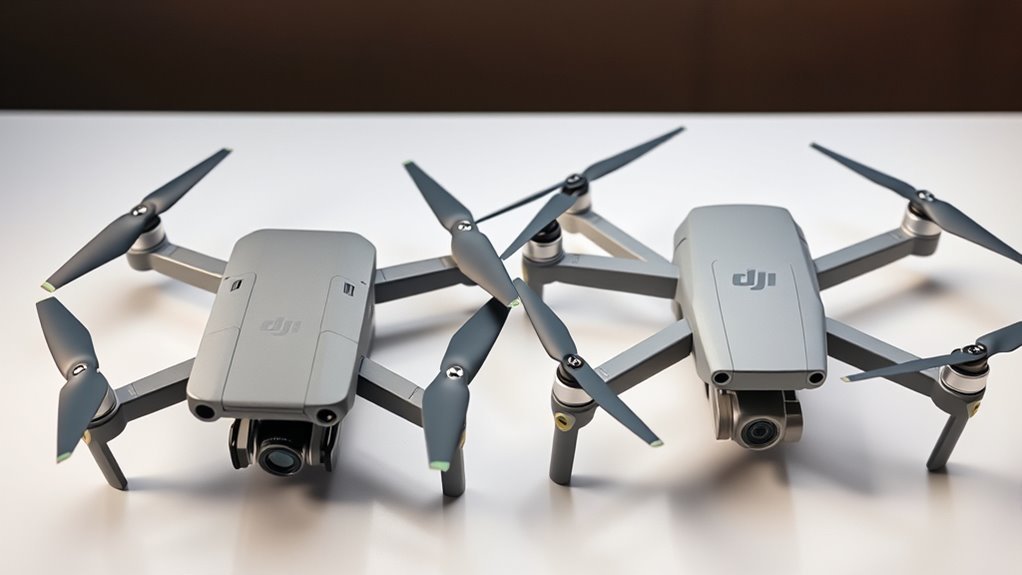When you’re weighing the DJI Air 3S against the Mavic 3 Classic, you’ll find the Air 3S’s lightweight 721g design boosts agility for quicker launches, while the Mavic’s 895g build emphasizes durability. Its 48MP dual-camera setup delivers sharp 4K HDR videos at 60fps, contrasting the Mavic’s Hasselblad 4/3-inch sensor for superior low-light color accuracy. Performance-wise, Air 3S offers 46 minutes of flight with better wind resistance. Further insights await on tailoring these to your shoots.
Design and Specifications Comparison
While the DJI Air 3S and Mavic 3 Classic both feature foldable designs for portability, you’ll notice key differences in their specifications that impact performance. The Air 3S’s design features a more compact footprint and advanced obstacle sensing system, giving you greater freedom to navigate tight spaces during your explorations. In contrast, the Mavic 3 Classic emphasizes robust build quality with reinforced arms, appealing if you’re seeking durability for rugged adventures.
When it comes to weight comparison, the Air 3S tips the scales at around 721 grams, making it lighter and easier to carry on spontaneous trips, whereas the Mavic 3 Classic weighs in at 895 grams. This difference enhances the Air 3S’s agility, allowing you to launch quicker and fly longer without fatigue. You’ll appreciate how these design features liberate your aerial pursuits, letting you focus on creativity rather than constraints. Overall, the Air 3S offers a sleeker profile for those prioritizing mobility, while the Mavic 3 Classic provides a solid foundation for demanding scenarios.
Camera Capabilities Analysis
Shifting our focus to camera capabilities, you’ll notice the DJI Air 3S equips a 1-inch CMOS sensor with 48MP resolution and dual-camera setup for 4K HDR video at 60fps, while the Mavic 3 Classic features a larger Hasselblad 4/3-inch sensor delivering 20MP stills and superior low-light performance through its 24mm equivalent lens. Regarding sensor technology, the Air 3S’s 1-inch CMOS offers versatile high-resolution captures, freeing you to explore dynamic scenes with its dual-lens flexibility, whereas the Mavic 3 Classic’s 4/3-inch sensor excels in low-light conditions, providing richer tonal depth for your aerial storytelling.
When it comes to image processing, the Air 3S leverages advanced algorithms to enhance 48MP shots, ensuring crisp details and quick HDR adjustments that empower your creative freedom. Conversely, the Mavic 3 Classic’s Hasselblad-tuned processing delivers superior color accuracy and noise reduction, ideal for professional-grade outputs without compromising on low-light fidelity. This comparison highlights how each drone’s sensor technology and image processing align with your desire for liberated, high-quality visuals, letting you choose based on shooting priorities.
Performance and User Experience
As we explore performance and user experience, you’ll notice the DJI Air 3S delivers up to 46 minutes of flight time with agile maneuverability and enhanced wind resistance, while the Mavic 3 Classic offers around 40 minutes of runtime paired with superior stability and advanced obstacle avoidance systems. When it comes to battery life, the Air 3S’s longer duration lets you roam freely over vast landscapes without frequent swaps, empowering your aerial explorations. In contrast, the Mavic 3 Classic’s robust battery life still guarantees reliable performance in demanding conditions. Regarding flight stability, the Mavic 3 excels with its advanced sensors for smoother handling in gusty winds, giving you more control during dynamic shots, whereas the Air 3S’s agile design suits quick, responsive flights in open spaces. Ultimately, you’ll appreciate how these differences enhance your freedom—whether you’re chasing horizons or maneuvering tight spots—with intuitive apps that minimize interruptions and maximize enjoyment.
Frequently Asked Questions
How Much Does the DJI Air 3S Cost?
You’re asking about the DJI Air 3S’s cost, which starts around $1,099 for the base model. This drone’s features, like its dual-camera system and 4K video capabilities, combined with specifications such as a 46-minute flight time and advanced obstacle avoidance, make it a powerhouse for your aerial adventures. You’ll enjoy the freedom to capture stunning footage without breaking the bank, empowering your explorations. Compare that to similar tech for unbeatable value.
Where Can I Buy the DJI Mavic 3 Classic?
Aren’t you itching to take flight with the DJI Mavic 3 Classic’s advanced imaging tech? You’ll find it at online retailers like DJI’s official store, Amazon, or Best Buy, offering easy comparisons on specs, prices, and fast shipping for your aerial freedom. Don’t overlook local stores such as electronics chains or drone shops for hands-on tests, ensuring you compare build quality and features before releasing your adventures.
What Warranty Options Are Available for These Drones?
When you’re exploring warranty options for drones like the DJI Air 3S and DJI Mavic 3 Classic, you’ll find DJI’s standard warranty coverage includes a 1-year period for both, protecting against defects and offering repair options through authorized centers. For greater freedom, you can compare and choose extended plans up to 2 years, covering parts, labor, and even accidental damage, ensuring you’re always ready to soar.
Do I Need a License to Fly These Drones?
You’re probably wondering if you need a license to fly these drones, so let’s investigate the theory that freedom in the skies means no restrictions. Under drone regulations, you’ll often require pilot certification for flights over 250 grams, like the DJI models. In the US, FAA rules mandate registration and possibly a PART 107 for commercial use, versus recreational TRUST training. Compare that to hobbyist exemptions, empowering your aerial adventures while staying compliant for true liberty.
Can I Use These Drones in Restricted Areas?
You’re asking if you can fly your drones in restricted areas, but you’ll need to navigate restricted airspace regulations carefully. Drone flight permissions are essential; without them, you’re prohibited from entering no-fly zones like airports or military areas. Both models demand the same FAA or local approvals for safe operation. To preserve your flying freedom, always check apps like AirMap beforehand and compare permission processes for seamless adventures. Don’t risk fines—plan ahead!

